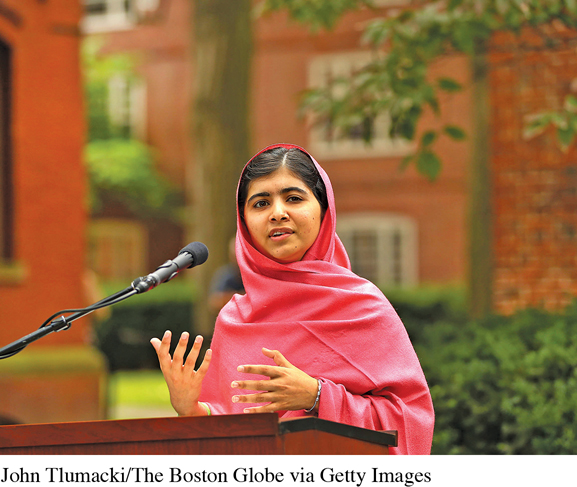Introduction to Chapter 5
132

133
Malala Yousafzai grew up in the Swat Valley of Pakistan. Her father, Ziauddin, was a poet and the owner of a chain of local schools. He also was an outspoken activist on behalf of women’s rights and the importance of education for girls. From the time Malala was very young, her father treated her as someone special, encouraging her to stay up late to discuss politics with him, long after her two brothers and mother had gone to bed.
Malala’s life changed dramatically when the Taliban seized control of the Swat Valley. They began systematically attacking and destroying girls’ schools, and women in the community were banned from going to the local market or even leaving their houses. Malala found such imprisonment intolerable, and—with her father’s support—she began blogging under an assumed name about her experiences, even though she was only 11 years old. However, when her true identity was publicly revealed, she didn’t retreat into hiding. Instead, she became an activist. As she describes,
Why should I wait for someone else to help us? Why don’t I raise my voice; why don’t we speak up for our rights? The girls of Swat, they spoke up for their rights. I started writing [a] diary; I spoke on every media channel I could and I raised my voice on every platform and I said, “I need to tell the world what is happening.”1
134
Early in 2012, a friend came to Malala and said that when she had Googled Malala’s name, a death threat from the Taliban popped up as a search result. Malala didn’t initially believe it, but when she saw it for herself, her first concern was for her father, not herself. She figured that he would be a more likely target, given that she was only a child. But the more she thought about a possible attack on her, the more she became convinced that, when facing her killer, she would talk with him rather than fight him.
I started thinking that if a Talib comes to kill me, what would you do? Then I would reply to myself, Malala, just take a shoe and hit him! But then I said, if you hit a Talib, then there would be no difference between you and the Talib. You must not treat others with cruelty, but through peace and through dialogue. Then I said, I would tell him how important education is and that I want education for [his] children as well, and I would tell him, “That’s what I want to tell you, now do what you want.”
On October 9, 2012, on her way home from school, a man boarded the bus Malala was riding in and opened fire on her and her friends. Although she almost died from her wounds, her commitment to dialogue between peoples separated by difference remains unfazed. Since the attack and her lengthy, difficult recovery, Malala has traveled the world as a global ambassador, advocating on behalf of women, education, equality, and cultural tolerance. As she details,
Going to school is not only learning about different subjects; it teaches you communication, it teaches you how to live a life. You learn about equality because students are provided the same benches; they sit equally. It teaches students how to live with others together, how to accept each other’s language, how to accept each other’s traditions and each other’s religion. It teaches us justice, respect, and how to live together.
135
Let’s face it: not all of us are as stunningly heroic as Malala Yousafzai. I’m most certainly not! Nor will many of us achieve the accolades she has. Malala gave a speech at the United Nations on her 16th birthday, July 12, 2013; has a best-selling autobiography, I Am Malala (2013); was awarded the European Sakharov Prize for Freedom of Thought in 2013; and is the youngest recipient ever of the Nobel Peace Prize (2014). At the same time, each of us has within us the capacity for acts of interpersonal heroism that mirror Malala’s anticipated approach for dealing with her assassin: “You must not treat others with cruelty, but through peace and through dialogue.” When facing those who seem separated from us by cultural distance—who we don’t understand, who make us uncomfortable, or whom we may even feel threatened by—the most important thing we can do is not lash out at them with a metaphorical “shoe” but, instead, engage them in dialogue marked by compassion, tolerance, and respect. When we do so, we embrace intercultural communication competence, creating the possibility for connections with, rather than separation from, culturally diverse others.
In this chapter, you’ll learn:
The defining characteristics of culture
What co-cultures are and their role in communication
The impact of prejudice on communication
The ways cultural differences influence how people communicate
How to improve your intercultural communication competence